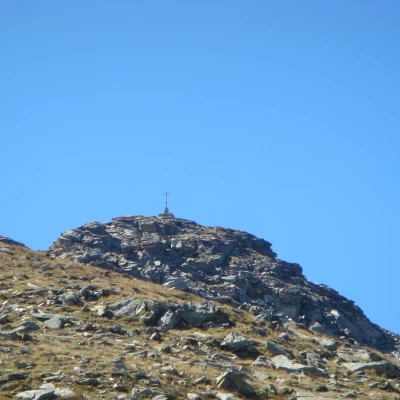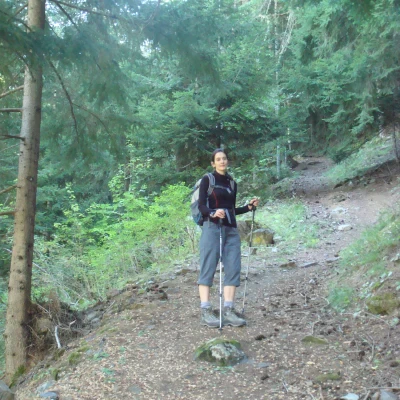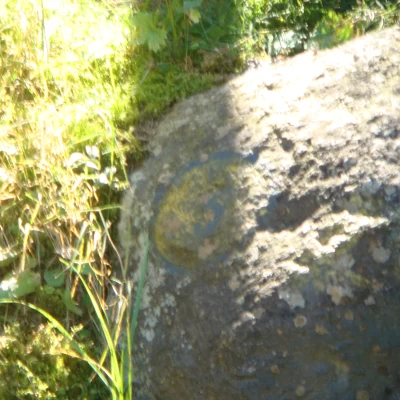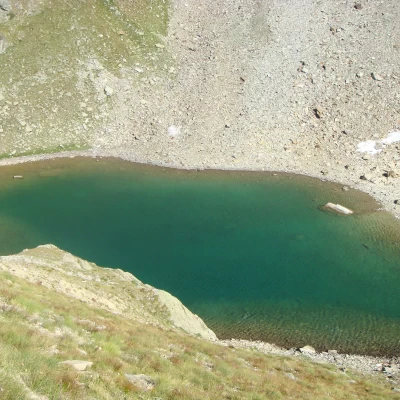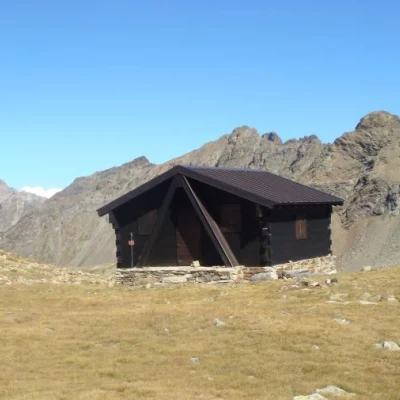Penne Nere bivouac, from the Valpelline sports area

Access
Highway to Aosta, exit Aosta East. Follow the road to San Bernardo and exit after the tunnel following the signs for Valpelline. When you reach the village of Valpelline, turn right after the main square, at a petrol station, following the signs for Camping Grand Combin. you can park after the campsite on the right. From the car park continue along the road and cross the Buthier stream on the bridge by the bar/restaurant.
.Description
WARNING from here, do not take the well-marked path on the left, which runs alongside the river and passes near a rock climbing wall unless you want to go up to Ronceaz by road, in which case turn right onto the road, pass a few hairpin bends and continue along the straight path to Ronceaz.(1095m) On our path, which is not very well marked, you must stay to the right after the restaurant until you come to a red ball indicating Plan de Ressa. From there we ascend through the forest to Ronceaz, turn right and on the wall there is an indication to continue to the left. Here we enter the forest, which, with a series of hairpin bends, climbs up to the track, which we follow for a couple of bends and a straight stretch. At the end of the straight stretch, after the bend, there is a faded sign on a stone indicating that we should continue through the forest on path no. 5. We pass over a small bridge. Enjoy it because it is the only flat section of the entire walk!!! After the bridge you start climbing again along the river. At the end of the forest (the path always runs alongside the river) you arrive at the ruins of Verney, where there are also signposts. (1730m) For path no. 5, it is advisable to stay to the right, passing by a drinking trough and over some stones until you find the path going up the meadows. If you follow the sign and climb closer to the trees, you run the risk of getting bogged down in streams half hidden by grass (the path is better marked downhill than uphill). When you reach the road, follow it as far as the Arpisson alpine pasture (1838m) and then start climbing again across the meadows to Porillon Alpe Neuve and from there up to Fouillou (2087m). The path now changes from meadows to rock and continues to climb to the beautiful Lake Arpisson (2482m). The ascent continues on a well-marked trail until reaching the Col de Viou, where trail 105 from Blavy also climbs. For the bivouac, you have to climb a little more and find it on the right at 2730m. The view from the col and the bivouac is exceptional. It still takes about 30 to 45 minutes to reach the Becca summit. It was a little late for us and we still had 1800m of descent to face. The Becca will be for another time, maybe starting from Blavy. Small note of disappointment: The trail, despite being long, offers great views, especially when you start climbing after Fouillou. The most travelled route is from Blavy, so going up from Valpelline you will find unspoilt landscapes ....... except, unfortunately, for some uncivilised person who left a can of Rio Mare near Lake Arpisson. Perhaps thinking that the 'famous alpine tuna' use the cans as a home to shelter from the cold????Access: Motorway to Aosta, exit Aosta Est. Follow the road to San Bernardo and exit after the tunnel following for Valpelline. Arriving in the village of Valpelline, turn right after the main square, at a petrol station, following signs for Camping Grand Combin. you can park after the campsite on the right. From the car park continue along the road and cross the Buthier stream on the bridge by the bar/restaurant. CAUTION: from here do not take the well-marked path on the left, which runs alongside the river and passes near a climbing wall unless you want to go up to Ronceaz by road, in which case turn right onto the road, pass a few hairpin bends and continue along the straight path to Ronceaz.(1095m) On our path, which is not very well marked, you should stay to the right after the restaurant until you reach a red ball indicating Plan de Ressa. From there we ascend through the forest to Ronceaz, turn right and on the wall there is an indication to continue to the left. Here we enter the forest, which, with a series of hairpin bends, climbs up to the track, which we follow for a couple of bends and a straight stretch. At the end of the straight stretch, after the bend, there is a faded sign on a stone indicating that we should continue through the forest on path no. 5. We pass over a small bridge. Enjoy it because it is the only flat section of the entire walk!!! After the bridge you start climbing again along the river. At the end of the forest (the path always runs alongside the river) you arrive at the ruins of Verney, where there are also signposts. (1730m) For path no. 5, it is advisable to stay to the right, passing by a drinking trough and over some stones until you find the path going up the meadows. If you follow the sign and climb closer to the trees, you run the risk of getting bogged down in streams half hidden by grass (the path is better marked downhill than uphill). When you reach the road, follow it as far as the Arpisson alpine pasture (1838m) and then start climbing again across the meadows to Porillon Alpe Neuve and from there up to Fouillou (2087m). The path now changes from meadows to rock and continues to climb to the beautiful Lake Arpisson (2482m). The ascent continues on a well-marked trail until reaching the Col de Viou, where trail 105 from Blavy also climbs. For the bivouac, you have to climb a little more and find it on the right at 2730m. The view from the col and the bivouac is exceptional. It still takes about 30 to 45 minutes to reach the Becca summit. It was a little late for us and we still had 1800m of descent to face. The Becca will be for another time, maybe starting from Blavy. Small note of disappointment: The trail, despite being long, offers great views, especially when you start climbing after Fouillou. The most travelled route is from Blavy, so going up from Valpelline you will find unspoilt landscapes ....... except, unfortunately, for some uncivilised person who left a can of Rio Mare near Lake Arpisson. Perhaps he thought that the 'famous alpine tuna' used the cans as a home to shelter from the cold????
.

